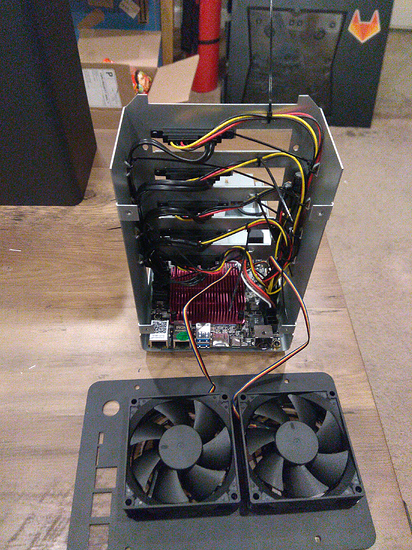https://wiki.kobol.io/helios64/intro/
@SgtAwesomesauce @wendell @Eden (if I left anybody out that I recalled was slightly interested in the device im sorry)… data and open-ness looks encouraging
The helios64, Just released. Good first spec revisions and tbch I think it might just live up to a bit of its hype. Dont take what I say below as knocking at it. This is me nit picking. It looks like a great device and once I see some positive solid reviews I will probably purchase it
Alright so some engineering issues I have that I am going to nit pick at which by all means could be improved im sure with firmware and other upgrades are the following
The battery pack is rated 7.2V 3180mAh (22.9Wh) with max continuous discharge of 10A. Thats cool and all but my issue with it is looking at powering any HDD’s with it would result in a very short discharge time. Now one could make a bigger battery pack but they note that they are using the TI BQ24133 charger & power path IC which does a good job at charging the battery in three phases: preconditioning, constant current, and constant voltage . Here is the thing it cant do. You cant limit discharge of a bigger pack between 30 and 80 percent. I suppose thats fine but not good for 18650 longevity. From the SoC / OS you will only be able to get the charge state. I wish it could release more data but Im pretty sure thats in the firmware and can only be addressed via serial… Again im sure one could hack the firmware a bit but thats not recommended.
Now from what I can gather the TI also has an unfortunate built in charging time limitation. It will stop charging regardless if the cells are not full by 9 hours. The 2 serial pack takes 4 hours to get to 100 percent. So a bigger battery pack would likely be limited to a 2S2P configuration which means at max you could double the capacity but in no way could you increase the maximum current discharge. So the batteries wont power disks. It will probably tells the system to shut down the disks and just power the ARM part of the NAS. At least I hope they do that so the UPS can be on for longer. It would defeat the point of the UPS providing full functionality. IDK 15 minutes full disk run time just seems a little weak
Now looking at their board design its possible you could change the resistor and allow for a bigger/greater current discharge and according to the TI data sheet you could change the resister on it to up the 1A charge current to 2.5A. IDK what this would do.
Its cool though I like what I am seeing. I think theres definitely room for improvement. UPS design wise they could do better. Overall Its pretty damn solid. I think the flashing process is a bit wonky but thats just ARM for ya
Id be interested to see this… I know its not standard but M.2 Wifi AX card. Be able to just store it away in a corner without ethernet. The latency is low. Wifi AX is reliable and its incredibly fast for what it is. It would allow for flexibility of placement. I just dont know if it can be done because its a SATA 3.0 connected M.2 not PCIE. Because of that im pretty sure only bluetooth would work because the system interface specification for intel wifi ax 200 is Wi-Fi(PCIe), BT(USB). So I guess the only way this would be possible is to wait for someone to release a USB 3.0 USB Qualcomm based Wifi AX module. Might take time but AX is kind of a generational step where I see more things that were wired becoming wireless which is something I really desire. Wires are lame lol








